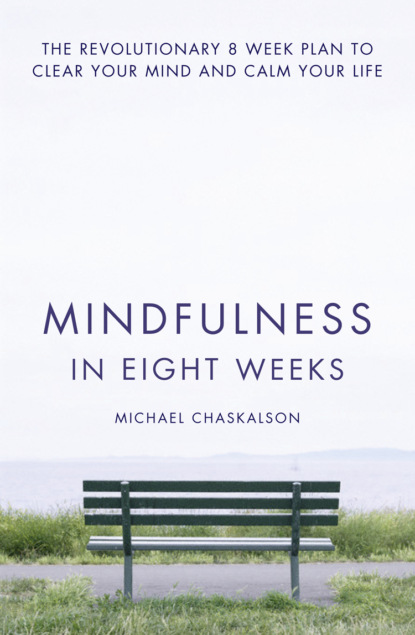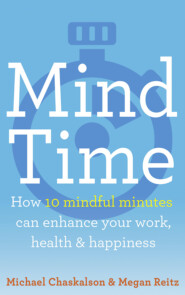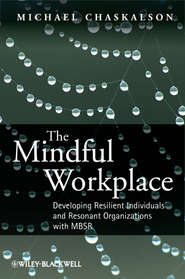По всем вопросам обращайтесь на: info@litportal.ru
(©) 2003-2024.
✖
Mindfulness in Eight Weeks: The revolutionary 8 week plan to clear your mind and calm your life
Автор
Год написания книги
2019
Настройки чтения
Размер шрифта
Высота строк
Поля
About the Publisher
Praise for Mindfulness in 8 Weeks (#u3b2ef7d1-f419-5379-a1bc-22133f64cfb8)
This book is a real joy ... Michael has laid it out clearly, succinctly and approachably. It’s a wonderful mix of clear, practical guidance and sound scientific evidence. Read this book, follow and practise the guidance, and enjoy the fruits!
Rebecca Crane, Director, Centre for Mindfulness Research and Practice, Bangor University
Before I met Michael I thought I knew all there was to know about my thoughts. I was wrong.
Eight weeks on I knew a feeling of space and calm. The internal chatter of my mind was there but not so demanding or noisy. Instead, I was just enjoying a new sense of seeing the world as it is rather than as the setting for my own thoughts.
David Sillito, Media and Arts Correspondent, BBC
This book provides a highly accessible way for people to learn mindfulness, experience its potential to relieve suffering, and cultivate joy, compassion and wisdom.
Willem Kuyken, Professor of Clinical Psychology, Exeter University
Mindfulness in Eight Weeks is a clear, practical and wise companion as you embark on the journey of transformation outlined in the book’s programme. With its balance of scientific knowledge, detailed meditation instructions and tips on how to bring mindfulness into daily life, it is indeed a trustworthy and accessible manual as, step by step, you change your mind and change your life.
Vidyamala Burch, Author and co-founder of Breathworks CIC
A great book for both novices and those familiar with mindfulness practice – I highly recommend it.
Mark Williams Co-Author of the bestselling Mindfulness: A practical guide to peace in a frantic world
The ideas and practices discussed here truly change lives.
Dr. John Teasdale Co-Author: Mindfulness-Based Cognitive Therapy for Depression
As we campaign in Parliament and in government to raise awareness of the benefits of mindfulness training more generally, I hope this new book will open many more eyes to the great benefits that are so readily available with mindfulness practice
Chris Ruane MP
Introduction (#u3b2ef7d1-f419-5379-a1bc-22133f64cfb8)
Mindfulness Is Everywhere (#u3b2ef7d1-f419-5379-a1bc-22133f64cfb8)
When I first started practising mindfulness in the UK back in the 1970s, very few people outside of Asia had heard of it. Now it’s everywhere. TIME Magazine devoted a recent cover to it, US congressmen and British Members of Parliament are vocal about its benefits, public courses abound, there are widely respected programmes available for schoolchildren and young adults, the US Marines are building it into their training, top corporations offer training in it to their employees, scientists study its effects (there are around 40 peer-reviewed scientific papers on the theme published every month) and NICE, the UK’s National Institute for Health and Clinical Excellence that advises the UK National Health Service on appropriate treatments, recommends an eight-week mindfulness course as a front-line intervention for certain conditions.
Almost every week another mainstream publication, a magazine or newspaper, carries an article that speaks of the popularity of mindfulness and its apparent benefits, and there seems to be an unending stream of books about it.
So Why Another Book?
Because it’s one thing just to read about mindfulness and quite another thing to practise it. The aim of this book is to support you in its actual practice. You can use the book as a do-it-yourself manual for learning mindfulness in a structured way or you can use it to supplement the teaching on a teacher-led eight-week mindfulness programme. You can also use it simply to find out more about the approach and to try some of the ideas and practices for yourself.
The book is built around an eight-week mindfulness course that is a combination of the two most popular and widely researched mindfulness approaches – Mindfulness-Based Stress Reduction (MBSR) and Mindfulness-Based Cognitive Therapy (MBCT). However you use this book, you will get the most from it by actually trying out some of the mindfulness practices taught here over a period of time.
My intention is for this book to be practical and – as much as possible in this medium – experiential. Although I will refer from time to time to the considerable scientific research into the effects of mindfulness training and I will be discussing some of the theory that underlies the approach, all of that is intended to support and illuminate the actual practice of mindfulness. The true meaning of mindfulness emerges ultimately from its practice and that is something you have to do for yourself. In the end, it is only by practising some of the methods of mindfulness that you can discover their real significance and begin to share in the very considerable benefits that they offer. Those benefits are really considerable – so many and various – and are accessible to people in a wide variety of contexts.
I teach mindfulness in many different settings these days. My associates and I run public self-enrolment eight-week mindfulness courses in London and elsewhere. We also bring programmes like the one outlined here to people in organisations – banks, Internet companies, media organisations, financial and professional services companies, the UK’s National Health Service and so on. I work with large groups or one-to-one with senior staff. I’ve taught people working at senior board level in large global organisations and I’ve worked in a space littered with potting compost teaching a course to the staff who run a plant nursery alongside clients who have learning difficulties. Sometimes we teach the full eight-week programme, sometimes we deliver a shorter introduction. We teach Mindfulness for Leaders courses and we teach mindfulness for general staff. But, however or wherever we teach, the basic premise of the work remains the same: when you’re more skilled at working with your mind and mental states things go better for you and for those around you.
After training in mindfulness myself for around 40 years now, and teaching others for much of that time, I feel I can say this unequivocally – mindfulness works.
How to Use this Book
The heart of this book is an eight-week mindfulness training course, and that is reflected in its structure. Each chapter comprises instructions for a particular set of practices that you can engage in that week. The practices are cumulative and follow one another in a particular order – building from week to week.
The core course material is laid out in one consistent style. All the other material – apart from the home practice – can be thought of as somewhat optional reading. These breakout boxes are marked with different icons:
The icon
tells you that a box contains instruction and guidance that are necessary for the course.
The icon
shows that the box contains ideas that I’ll be referring to as the course unfolds.
The icon
shows that the box contains a description of the set home practice for this week.
The icon
lets you know that the box marked by it contains useful information that is not absolutely necessary for you to know as you follow the course. Read it if you’re interested, or skip it if you’d rather.
The icon
tells you that the box contains a poem or a story that further illustrates some of the points being made in that chapter.
I have also provided downloadable audio materials to support each week’s mindfulness practice. These can be found at www.mbsr.co.uk/mp31.php (http://www.mbsr.co.uk/mp31.php). There are two streams of daily practice that you can follow. The first stream follows the home-practice pathway of ‘classic’ MBSR and MBCT in suggesting that you do at least 40 minutes of home practice each day. Most of the research findings showing significant changes as a result of engaging in MBSR or MBCT have been based on a daily practice programme similar to this.
If you’re using this book as part of a teacher-led group-based eight-week course, do follow Stream 1 home practice unless your instructor suggests otherwise.
Having said all that, I’m aware that undertaking 40 minutes a day of home practice, especially without the support of a group, can be a real challenge. For that reason I’ve devised a second stream of practice. Stream 2 home practice takes no more than 20 minutes each day and may be useful for those who are using the book alone to guide their mindfulness training and who don’t have regular access to a teacher-led group.
The daily practice programme for each week of the course is laid out at the end of the chapter for each week, and Stream 1 and Stream 2 home-practice guidance is clearly delineated.
Finally, if you’re using the book as part of a teacher-led course, you’ll get the most from that course if, once you’ve read this introductory chapter, you leave any further reading until after you have participated in that week’s class with the teacher. Try to avoid reading ahead – it can undermine the effects of the work you’ll be doing on the course itself.
Home Practice is Essential
As you’ll see from the outcomes described in the book, with regular daily mindfulness practice real changes are possible. What is on offer here is a significant increase in your level of well-being and personal effectiveness. I’m personally committed to teaching mindfulness and I’m inspired to do that because I see real changes taking place from week to week in the people I work with. It’s not always a smooth journey. There are ups and downs and we tell people on our public courses that engaging in the stress-reduction courses we offer can sometimes be stressful. After all, for many people these days finding 40 minutes a day to fit in the practices really isn’t easy. But practice is what this is all about and, if you commit to your stream of practice and do it with whatever regularity you can muster, real change can follow.
And here’s the really wonderful thing: as you set out on your journey into mindfulness you don’t have to try to change yourself. In fact, striving after results can inhibit the process. All you have to do is engage in the practices – again and again and again – and change will begin to emerge. Over time, some people find that, once they have begun to experience for themselves the attitude of kindly self-acceptance that lies at the heart of this programme, they want to engage in further processes of development which build on that foundation. In the ‘Further Resources’ section (see here (#litres_trial_promo)) I discuss a few of the many options that may be available, but for now the main thing is simply to engage in the practices described for each week. As best you can, put aside any idea of getting them right or doing them perfectly. That striving attitude is perfectly normal, it’s part of our being human, but in this context it just gets in the way.
Don’t strive to get the practices right. Just do them.
And here’s another great thing. On this course you’re completely liberated from any obligation to enjoy the practices. Sometimes you may enjoy them, sometimes you may not. That’s not the point. You don’t need to enjoy them to get the benefit – but you do have to do them.







